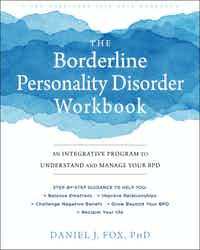By Daniel Fox, author of The Borderline Personality Disorder Workbook
It is not uncommon for individuals with borderline personality disorder (BPD) to experience the comorbid complexity of depression. It is estimated that as many as 83% of individuals with BPD have a co-occurring depressive disorder (Beatson & Rao, 2012). Due to this tendency, many individuals initially present to treatment with depressive symptoms, and over the course of treatment, the clinician begins to realize that a more complex clinical issue is at hand: comorbid BPD.
The symptom overlap of depression and BPD is significant and complex. These individuals present as sullen; tend to report passive and active suicidal ideation and intent with co-occurring non-lethal self-harm acts; affective instability that includes intense episodic dysphoria; frequent temper outbursts, agitation, and irritability that mimics depression with anxious distress; as well as reported feelings of emptiness and stress-related paranoia with severe dissociative symptoms that simulate depression with psychotic features.
Distinguishing Depressive Symptoms and BPD
Depressive symptoms that occur in those with BPD are due to an identifiable stressor (i.e., instance of rejection, perceived abandonment) but depression remits when the stressor is removed or the relationship is restored. Depressive symptoms may be a means to communicate what is going on emotionally inside the client, such as anger, frustration, helplessness, disappointment, and so on.
Is BPD an Affective Disorder?
BPD is often confused and misconstrued as an affective disorder (depressive or bipolar disorder), but when only the depression is treated the symptoms perpetuate. When the BPD symptoms are addressed, and the individual learns thought, feeling, and emotional identification, management, and adaptive skills, the depression subsides in conjunction with the BPD symptomatology.
What about Medication?
There is no data to guide clinicians in choosing a specific medication for depression when it’s comorbid with BPD. In addition, there’s increasing apprehension regarding the use of medication for BPD because of its limited effectiveness and concerns about iatrogenic harm, obesity-related health problems, and interaction effects that can occur when multiple medications are used to address a myriad of fluctuating symptoms.
This is a common issue for treatment providers and individuals with BPD. That doesn’t mean don’t take medication, but explore options as a treatment team to arrive at the best intervention as the client progresses in therapy. A medication that proves useful at the start of therapy may not be as effective or necessary in later therapeutic stages, as the client learns adaptive coping strategies.
Medication or Therapy?
Major depressive disorder (MDD) is not a significant predictor of outcome for BPD, but BPD is a significant predictor of outcome for MDD. Psychotherapy should take priority when BPD co-occurs with depression, as once the BPD symptoms attenuate, so will the depression.
Several types of psychotherapy have been found to effectively treat BPD, including dialectical behavior therapy (DBT), mentallization-based treatment (MBT), interpersonal psychotherapy, transference-focused therapy, schema-focused therapy, and supportive psychotherapy, which also results in lowered levels of depression.
Treatment Steps
When you believe a client may have depression comorbid with BPD:
- Identify the symptoms related to BPD outside of depressive symptomatology.
- Find the underlying driving force for the BPD symptoms; this is the client’s “core content” (i.e., abandonment).
- Determine how the core content is driving BPD symptoms? For example, if the client has abandonment issues, how does your client think, feel, and behave when perceived abandonment occurs?
- Help your client recognize the connection between perceived abandonment and BPD and depressive symptom expression.
- Teach your client adaptive coping strategies, such as mindfulness, relaxation, or healthy distraction, when core content is triggered.
- Address the fear of letting go of old maladaptive patterns; “no one will love me if I’m not depressed or broken.”
- Teach your client new ways to see them themselves and their world without their core content, fear, and maladaptive strategies.
Reference
Beatson, J. & Rao, S. (2012). Depression and borderline personality disorder REPLY. The Medical Journal of Australia, 197: 24-27.
 Daniel J. Fox, PhD, is a licensed psychologist in Texas, an international speaker, and award-winning author. He has been specializing in the treatment and assessment of individuals with personality disorders for over fifteen years in the state and federal prison system, universities, and in private practice. His specialty areas include personality disorders, ethics, burnout prevention, and emotional intelligence. He has published several articles in these areas, and is author of The Clinician’s Guide to the Diagnosis and Treatment of Personality Disorders; Narcissistic Personality Disorder Toolbox; and the award-winning Antisocial, Borderline, Narcissistic and Histrionic Workbook.
Daniel J. Fox, PhD, is a licensed psychologist in Texas, an international speaker, and award-winning author. He has been specializing in the treatment and assessment of individuals with personality disorders for over fifteen years in the state and federal prison system, universities, and in private practice. His specialty areas include personality disorders, ethics, burnout prevention, and emotional intelligence. He has published several articles in these areas, and is author of The Clinician’s Guide to the Diagnosis and Treatment of Personality Disorders; Narcissistic Personality Disorder Toolbox; and the award-winning Antisocial, Borderline, Narcissistic and Histrionic Workbook.


 2024 Peace Playbook: 3 Tactics to Avoid Clashes with Your Partner
2024 Peace Playbook: 3 Tactics to Avoid Clashes with Your Partner